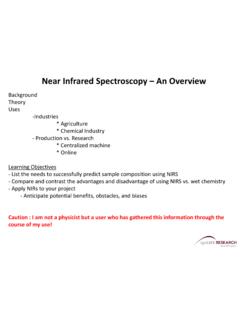Transcription of INFRARED THERMOGRAPHIC INSPECTION - tegg.teggpro.com
1 INFRARED THERMOGRAPHIC INSPECTIONThe THERMOGRAPHIC Electrical InspectionThe intent of the THERMOGRAPHIC Electrical INSPECTION is to assist in detecting potential equipment failureby measuring abnormal temperature signatures of Electrical Distribution System the operating condition of these components, potential failures can be located and problemseverity determined as part of a structured ongoing maintenance program. This will provide yourorganization with a predictive and proactive risk management program where outages and repairs ofyour electrical system can be objects around us including ourselves are constantly emitting thermal radiation (heat). This techniquefor making energy visible is called INFRARED Thermography.
2 The thermal image captured by thethermographic camera allows for meaningful interpretation. Data it contains is digitally stored andcomputer processed for further analysis. This information is stored for future reference and FormatAny thermal anomalies are presented on a report page as a thermal image and a digital photograph ofthe electrical component. To best determine the severity of a problem direct temperature measurementof the equipment and the temperature differential of the faulty components are the ResultsThermographic inspections should be performed under normal equipment load conditions. Whenequipment can be measured under normal operating conditions the following information can be used asa guide for the action to be TemperatureElectrical distribution system components are designed to operate within certain temperatureparameters.
3 When electrical distribution system components continually operate in excess of thoseparameters their life is shortened directly proportional to the amount of excess DifferentialAreas of electrical components operating at higher temperatures than that of adjacent areas,comparisons to ambient air temperatures, and enclosures of electrical apparatus are typically anindication of a problem with the higher temperature part. For every problem, components are always inspected for physical damage to determine if thecomponent should be replaced rather than repaired. An INSPECTION should be made after a problem hasbeen repaired to ensure it has been properly a guide to determining the severity of a problem we recommend for any of the three classifications ofinfrared testing on electrical components.
4 It should be noted that these temperature criteria's areemployed in conjunction with other analysis procedures and tools in the interest of accurately identifyingproblem areas: SIMILAR COMPARISONS - Components/Conductors that have equal or near equal loading Problem LevelAlertSevereCritical Temperature Differential F-36 C-20 F-72 C-40 C>72 F40 CDescriptionFirst Stage. Monitor and repair during next scheduled Stage. Should be repaired before scheduled Stage. Should be repaired immediately!Problem LevelAlertSevereCritical Temperature Differential 2 C-3 F-9 C-5 C9 F>5 CDescriptionFirst Stage. Monitor and repair during next scheduled Stage. Should be repaired before scheduled Stage. Should be repaired immediately!
5 References: NFPA - 70B Standard, NETA, and EPRIP roblem LevelAlertSevereCritical Temperature Differential C-8 F-27 C-15 C>27 F>15 CDescriptionFirst Stage. Monitor and repair during next scheduled Stage. Should be repaired before scheduled Stage. Should be repaired immediately!References: NFPA - 70B Standard, NETA, and EPRIR eferences: NFPA - 70B Standard, NETA, and EPRI AMBIENT COMPARISONS - Components/Conductors with no other items of similar load and ambient air is used as a reference INDIRECT COMPARISONS - Temperature observed across enclosed, electrical compartments and liquid/oil filled electrical items The above criteria provide standardized guidelines when determining if a thermal anomaly warrants further investigation based on temperature difference.
6 Other factors such as ambient temperature, environmental conditions, criticality of the equipment, and electrical analysis tests must be considered.





